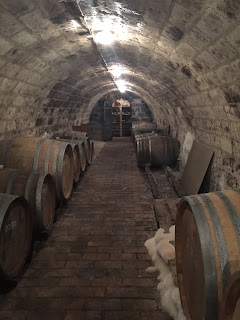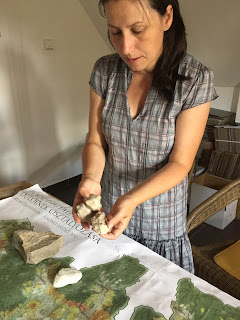|
|
After our visit with Heidi Schrock this summer in Rust, Austria, my husband and I made the five-hour drive to eastern Hungary to visit the town of Tokaj, home to the aptly named Tokaji sweet wine, which has been made for centuries in this quiet, unassuming corner of Eastern Europe. Schrock telephoned a winemaker friend in Tokaj before we left, resulting in a warm invitation to her winery, which we promptly accepted.
I was really excited about this part of the trip as I had read about the wines of Eastern Hungary for years, but rarely got a chance to taste them. Tokaji wines are legendary, dating from more than 400 years ago. For centuries, Hungary was renowned for its food and wine culture and also for having the most varied native grapes in any Eastern European country. They were also the first wine area to classify growths (yes, before they did it in Bordeaux!). But that all came crashing down under the weight of the communist regime, and for decades the ancient wine cellars and vineyards of Tokaj suffered with the indifference of the communists, and time-tested standards were all but abandoned. Grape vines were ripped out of prime hillside vineyards and replanted with money-making crops such as sunflowers and corn, and cellar practices slid to sub-par levels.
But since the late 1980s and the fall of communism, winemakers in Hungary have been rising up and reclaiming their legendary past. Prime vineyard locations are once again growing such grapes as Furmint, Harslevelu, and Sargamuskotaly — the principal varieties that make up Tokaji wine. And viticulture and vinification practices are once again, in most cases, stellar. In recognition of its past and in order to protect its future, UNESCO declared Tokaj a World Heritage Site in 2001.
Judit Bodo and Bott Wines
Using their wedding money, winemaker Judit Bodo and her husband Joseph rented their first Tokaj vineyard — 1 hectare — and a cellar and produced their first vintage in 2005. Called “Bott,” which is Judit’s maiden name, the wines are traditional Tokaji, from indigenous varieties, and range from bone dry Furmint to super sweet Harslevelu. As of summer 2015, the couple has 5 hectares of vines scattered throughout the region and a cellar in the Tokaj Hill, which they purchased recently from a retiring winemaker. This is where we met Bodo this past July.
On this hot and muggy summer day, our tour began with a drive up to Bott’s vineyards on the Tokaj Hill, guided by the friendly Judit. She had just left her three young children at home with her husband, who oversees the vineyard side of their business. She proudly showed us her vines, but was lamenting the heat and lack of water this summer. She was envious when we told her about the sudden downpour in Rust, Austria, the day before. Bodo described the soils of the Tokaj Hill, explaining that they are varied, created from the 400+ volcanoes in the area. This is prime vineyard land.
Our visit with Bodo continued with a tour of her cellar, which was fascinating. You enter the building from a quaint and unassuming building at the base of the hill (photo above), but the cellars themselves are built into the hill, creating a cave-like atmosphere, replete with cobwebs, fungus (see white stuff in picture to left), and lovely cool air suitable for aging wines.
Bodo says she and her husband “are two steps away from our dream” of having an official tasting room. But in the meantime, the upstairs room, which offers a pleasant view of the Tokaj train station across the street, was fine for us. While we sampled her lovely wines, Bodo proudly showed us a framed New York Times article, titled Hidden in Hungary, Treasures on the Vine (July 2010), in which she appears, and brought out geologic maps and soil and stone samples to give us a lesson on Tokaj, and why the wines are so special.
Bott’s wines are artisanal, obviously made with attention to detail. The winery produces just about 1,000 bottles per vintage, sometimes less, sometimes none, depending on Mother Nature. No doubt about it, this is a small operation, but you get the impression that Bott, like other small wineries in Hungary, is striving for excellence.
“The communists damaged everything,” said Bodo, referring to the state of the wine industry during their reign. While small wineries like Bott are working to bring back the glory of Tokaj wines, Bodo says the large companies, such as Disznoko (which we visited later the same day), owned by French insurance giant AXA Millesimes, are important too, as they too focus on quality but also bring in the tourists so badly needed in this corner of Hungary. This is not a “wine trail” type of area, with open tasting rooms everywhere. You have to know where you are going, make an appointment, and be prepared to have a private, intimate tasting. My husband and I were two of the few non-Hungarians in town, and felt a certain pride in knowing we had visited a place so few Americans even know about.
I do hope that Tokaj tourism picks up, and I highly recommend it as a stop on your Central European wine travels. In the meantime, if you haven’t done so, try a Tokaji sweet wine at the end of a special meal. You will love it.
Until next time, Egeszsgedre!
Some of Bott’s wines are available at The Wine House (www.winehouse.com) in West Los Angeles. You can also check www.wine-searcher.com for retail outlets near you.
Read Part 1 and Part 2 of my Women of Wine series.




